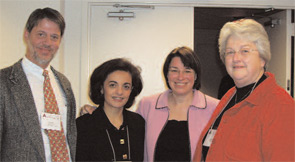As a girl growing up in rural Montana, Larissa Bates remembers terrible pain in the joints of her feet. Reeling from this daily pain, and lacking the energy of a typical 11-year-old, she went to a general physician because then—as now—no rheumatologist practiced nearby. But the doctor “just kept treating my pain symptoms,” Bates recalls, “never knowing that I actually had an underlying autoimmune disease.”
That changed when Bates was 24. “I woke up one day—it was January of ’98—and I just felt this terrible, all-over pain.” She went to a rheumatologist in Missoula, Mont., who finally diagnosed her with RA. “It was a relief to know that, OK, there is something wrong with me, like those 15 years living with the disease had been validated.”
On March 12 and 13, Bates joined 60 other patient advocates, rheumatologists, and rheumatology health professionals in Washington, D.C., for the ACR’s Advocates for Arthritis Day. The advocates’ top priority: to urge legislators to support the Arthritis Prevention, Control, and Cure Act of 2007 and three other legislative issues that affect the rheumatology field. (See “Make Our Voice Heard,” for more information.)


Strong Support from Rheumatology Community
“The event was very well received,” says Aiken Hackett, specialist of government affairs at the ACR and head organizer of the conference. In the weeks since the event, she says, “members of Congress have contacted us for more information—and that means they’re listening.”
The Arthritis Prevention, Control, and Cure Act was first introduced in the 108th congress—and again in the 109th—by U.S. Senators Kit Bond, R-Mo., and Edward Kennedy, D-Mass. In both years, however, the bill never made it out of subcommittee deliberations.
Last time, the bill had 220 co-sponsors in the House and 49 in the Senate. “When we tell them that now, that really gets their attention,” says ARHP member Ann Kunkel, a pediatric rheumatology education coordinator at the University of Kansas Medical Center in Kansas City. “It says: This is a bipartisan bill. And this year I’m amazed.” At press time, the bill had 121 co-sponsors in the House and 28 in the Senate.
Because Kennedy is the chairman of the Senate Health, Education, Labor, and Pensions Committee—which is deliberating over the bill—Kunkel is confident the bill will make it to a floor vote this year.
This year, advocates say, passing the bill is more important than ever. Arthritis now affects 46 million American adults. “And the baby-boom generation is now entering retirement,” Kunkel says, “so in the next 10 years, we’re going to see a huge increase of people with osteoarthritis and other kinds of arthritis problems.” Indeed, the Centers for Disease Control and Prevention (CDC) estimates that by 2030, nearly 67 million—that’s 25%—of Americans will have arthritis.
Busy Visit for Volunteers
The ACR advocates—including 22 patients, 21 physicians, and 17 members of the ARHP—arrived in Washington on March 12, and began their full schedule of events at the Washington Court Hotel. They spent the afternoon at a training session, led by two seasoned lobbyists, on how to effectively talk to elected representatives. A staff member from the House Energy and Commerce Committee also dropped by to talk candidly about health priorities in the House.
“They told us the dos and don’ts,” says Joseph Flood, MD, chair of the ACR Government Affairs Committee. The dos: be well informed, unafraid, and above all, brief—Congressmen can usually only give 10- or 15-minute appointments. The don’ts: “Don’t knock another disease, don’t be untruthful,” says Dr. Flood. “It’s not necessary to talk to them about who you voted for or who you contributed money to.”
After the training session, advocates met for dinner and keynote presentation from an animated staffer from the House of Representatives. “It was awesome to be able to socialize with everybody who was fighting for the same cause,” Bates says.
On March 13, the advocates collectively visited 122 Congressional offices; on 21 visits, the advocates met with their actual representatives, as opposed to staff. The biggest issue they discussed was the passing of the Arthritis Prevention, Control, and Cure Act, which focuses on federal funding of arthritis research, recruitment of more doctors into the rheumatology specialty, and public-education campaigns. Federal funding for arthritis research has declined since 2003. Today, National Institutes of Health (NIH) funding amounts to less than $8 per person with arthritis.
A Case for Research and Care
The funding issue is especially critical to Deborah McCloskey, co-chair of the ARHP Advocacy Subcommittee, who for the past 19 years has worked as a nurse at the scleroderma program at the University of Medicine and Dentistry of New Jersey-Robert Wood Johnson Medical School in New Brunswick. Because scleroderma affects only about 300,000 people nationwide, pharmaceutical companies don’t invest in scleroderma research, and the field relies on federal support.
McCloskey’s clinic recently took part in one NIH-funded study evaluating cyclophosphamide on scleroderma lung disease patients. One of her more severe patients, Joseph Berardi, had terrible lung function and decided to enroll in the study. After two years on the drug, Berardi’s lung function has improved dramatically—as was the case for most of the 144 other subjects.
The study’s positive results were published in the June 22, 2006, issue of the New England Journal of Medicine. Still, “that whole time, there was always the threat of funding being cut,” says McCloskey. “The NIH is the primary source of funding for clinical research, and the only way were going to make any advances is through clinical research.”
McCloskey brought Berardi and his wife to the Hill for this year’s Advocacy Day. “Every single office we visited said absolutely they would support the NIH issues after hearing his story.”
The proposed legislation also addresses the dearth of pediatric rheumatologists in the United States. About 300,000 U.S. children have arthritis, with only 162 pediatric rheumatologists to treat them—and 13 states don’t have a single pediatric rheumatologist. Dr. Flood explains that the needs of a child rheumatology patient—with their growing bones and active lifestyles—are fundamentally different from that of an adult. “I frequently joke that children are a different species than adults,” he says. The Arthritis Prevention, Control, and Cure Act supports incentives, such as the repayment of student loans, to encourage health professionals to specialize in pediatric rheumatology.
With arthritis now the leading cause of disability in America, public educational campaigns about disease prevention are of utmost importance. “There are even primary care doctors who aren’t aware of major advances,” Kunkel says. “If you get to your doctor early in your disease, we actually have therapies now that can prevent it from becoming disabling.”
The economic benefits of prevention especially resonated with lawmakers this year. Every patient who is able to work, as opposed to collecting disability payments, reduces the country’s astronomical costs of healthcare. In 2003, U.S. arthritis treatment costs totaled $127.8 billion, up from $86.2 billion in 1997, according to CDC figures. “It’s not too hard to figure out that would be good for the nation,” Kunkel says. “As one legislator told me, this is a no-brainer bill.”
Advocates Head Home with Hopes High
What was Congress’s overall reaction to the advocates?
“It depends on the member,” Hackett says. “Almost all of Congress has people working on health issues; it just may not be their priority.”
Kunkel says that the recent political climate has changed these priorities. “I’ve never met a Congressman opposed to the bill. But the Iraq War has taken a lot of the nation’s attention, and I think some of that would have gone to healthcare.”
Still, most of the advocates left Washington feeling overwhelmingly optimistic.
Just a few weeks after returning to Montana, in fact, Bates received a letter from the office of her senator, Max Baucus. “The Senator is taking a look at this legislation and doing everything he can to make sure that beneficiaries like you get the care you need,” the letter read. “He was very impressed by your presence and is committed to working on the issue this year.” The Arthritis Prevention, Control, and Cure Act, the letter later stated, will most likely come up for consideration in spring or late summer.
Virginia Hughes is a medical journalist based in New York City.
Why Do YOU Volunteer?

“Advocacy is so important right now because there are certain things that can only happen by going through Congress. It’s one of our American rights—shame on us if we don’t take the time to get involved.”—Ann Kunkel, ARHP

“One of the really refreshing things about all this is how much doctors and other healthcare providers care about their patients getting their due from the federal government. They give up time from their practices and families, go off to Washington, eat rubber chicken and sleep on uncomfortable beds, and make a difference—I hope.”—Joseph Flood, MD, chair of the ACR Government Affairs Committee
“A lot of people are under the misconception that physician reimbursements and NIH funding are physicians’ issues—but they have everything to do with what [nurses] do. It really affects everyone on the team. We’re all here to provide the best possible care for our patients, and it really does impact how we all function.”—Debbie McCloskey, chair of ARHP Advocacy Committee


